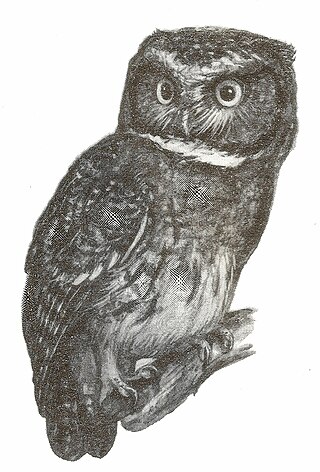
The white-throated hawk is a bird of prey in subfamily Accipitrinae, the "true" hawks, of family Accipitridae. It is found in Argentina, Bolivia, Chile, Colombia, Ecuador, Peru, and Venezuela.
The Andean rat, or white-tailed akodont, is the only species in the genus Lenoxus. It is a rodent in the tribe Akodontini found on the eastern slopes of the Andes of eastern Peru and western Bolivia. Examination of its genome shows that this species is not closely related to Oxymycterus as had previously been thought, but is quite distinct, having diverged from the other Akodontini soon after the basal radiation of the entire group.

The mountain paca is a small burrow-dwelling rodent whose habitats are high altitude South American forests. Pacas are nocturnal, sedentary, and solitary animals with territorial tendencies. It eats mostly fruits and seeds. The mountain paca primarily inhabits higher Andean montane forest regions in Venezuela, Colombia, Ecuador, Peru and Bolivia.

The dusky caenolestid, also known as Tate's shrew opossum, is a shrew opossum from South America. The dusky caenolestid is characterized by a dark brown coat with a lighter underbelly, soft and thick fur, and a loosely haired tail. A nocturnal animal, the dusky caenolestid lives on trees and feeds on insects and small invertebrates and vertebrates. It occurs in alpine and páramo forests in northern and western Colombia, Ecuador, and western Venezuela. The IUCN classifies this shrew opossum as least concern.
Neacomys spinosus, also known as the common neacomys, common bristly mouse, or bristly mouse, is a nocturnal rodent species from South America in the genus Neacomys. It is found in Bolivia, Brazil, Colombia, Ecuador and Peru, where it often lives in transition areas between lowland forest and open regions. Its diet consists of insects, seeds and fruit.

The Tropical Andes is northern of the three climate-delineated parts of the Andes, the others being the Dry Andes and the Wet Andes. The Tropical Andes' area spans 1,542,644 km2 (595,618 sq mi).

The speckled hummingbird, is a species of hummingbird. It is the only member of the genus Adelomyia. It inhabits Neotropical montane cloud forests at elevations of 1,000–2,500 meters and is confined to the Andes of Argentina, Bolivia, Peru, Ecuador, Colombia and Venezuela; as well as to some isolated montane forest in western Ecuador and Venezuela. In Ecuador, it ranges across both eastern and western slopes of the Andes and occupies a broad altitudinal range from subtropical forests to cloud forests. In addition, one isolated population inhabits the Chongón Colonche cordillera in coastal evergreen montane forest located ca. 130 km away from the Andes.

The white-throated screech owl is a small owl found in the Andes of Bolivia, Colombia, Ecuador, Peru and Venezuela.
Microryzomys altissimus, also known as the Páramo colilargo or highland small rice rat, is a species of rodent in the genus Microryzomys of family Cricetidae. It is found in Colombia, Ecuador, and Peru, but the Colombian segment may be a separate species.
Microryzomys is a genus of rodent in the tribe Oryzomyini of family Cricetidae. It is closely related to Oreoryzomys, Oligoryzomys, and Neacomys. It contains two species, both restricted to the Andes: M. altissimus and M. minutus.
Oligoryzomys destructor, also known as Tschudi's colilargo or the destructive pygmy rice rat, is a species of rodent in the genus Oligoryzomys of family Cricetidae. It is found along the eastern Andes from southern Colombia, through Ecuador, Peru, and Bolivia into northern Argentina. Its karyotype has 2n = 60 and FNa = 76.
Coues's climbing mouse is a species of rodent in the family Cricetidae. It is found in Colombia, Ecuador, Peru, Trinidad and Tobago, and Venezuela. It is named in honour of the American zoologist Elliott Coues who studied birds and small mammals.
The golden Oldfield mouse or golden thomasomys is a species of rodent in the family Cricetidae. It is found in Colombia, Ecuador, Peru, and Venezuela. Both the common and genus name commemorate the British zoologist Oldfield Thomas who worked at the Natural History Museum, London and studied South American rodents.

The wattled guan is a species of bird in the family Cracidae. It is a fairly large black cracid with blue-based, black-tipped beak and a long, red-and-yellow wattle.

The lyre-tailed nightjar is a species of nightjar in the family Caprimulgidae. It is found in Argentina, Bolivia, Colombia, Ecuador, Peru, and Venezuela.

The violaceous jay is a species of bird in the family Corvidae, the crows and their allies.

The pale-footed swallow is a species of bird in the family Hirundinidae. It is found in the northern Andes, from Venezuela to Bolivia. It is monotypic.

Thomasomys ucucha, also known as the ucucha thomasomys, is a rodent in the genus Thomasomys of the family Cricetidae. It is known only from high altitude forest and grassland habitats in the Cordillera Oriental of Ecuador. Seven other species of Thomasomys live in the same areas. First collected in 1903, T. ucucha was formally described as a new species in 2003 and most closely resembles T. hylophilus, which occurs further to the north. The species is listed as "vulnerable" in the IUCN Red List as a result of habitat destruction.

The Eastern Cordillera Real montane forests (NT0121) is an ecoregion in the eastern range of the Andes of southern Colombia, Ecuador and northern Peru. The ecoregion covers the eastern slopes of the Andes, and includes montane forest that rises from the Amazonian rain forest, with cloud forest and elfin forest at higher elevations. It is rich in species, including many endemics. It is threatened by logging and conversion for pasturage and subsistence agriculture.











